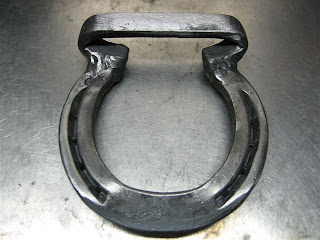The Patent bar horseshoe, is used to keep a horse from bearing weight on an injured leg. The shoe features a bar between the heels, which is raised 1 to 1½ inches to decrease the angle between the pastern and the cannon bone. In doing so, the shoe relieves stress on the flexor tendons and suspensory ligament.
(The above shoe was constructed by David Boles and Marcus Lybarger)
The tenosynovitis imaged below is that of a horse with a severe injury to its deep digital flexor tendon in the pastern area (see ultrasound pic below). The horse was a grade 4/5 lame at the walk and was not willing to place his heel on the ground. By setting a patent bar shoe on the affected leg, the horse can bear weight on the limb with minimal strain on the injured deep digital flexor tendon. Over time, the heel elevation of the patent bar shoe is lowered until the horse is walking normally on the limb. This process usually takes 2-6 months depending on the extent of the injury. In addition, daily walking is encouraged to minimize the development of adhesions within the injured tendon/ligament. During the rehabilitation period, we recommend daily ice therapy, topical Surpass cream, and a series of extracorporeal shockwave treatment over the injured tendon/ligament.
Severe tendinitis of the deep digital flexor tendon in the area of the pastern. The image on the left is a longitudinal view and the image on the right is a cross-sectional view of the same lesion. The dark or black area in the center of the image corresponds to fluid accumulation and fiber disruption (core lesion) within the body of the deep digital flexor tendon.







Very nice blog. The above shoe is a patten bar shoe, rather than a "patent" shoe, the origins of the name likely derived from the patten shoes worn in the middle ages to elevate one's feet out of the mud. A wikipedia search for patten shoe will show the human version or namesake for the shoe. Keep up the good work.
ReplyDelete